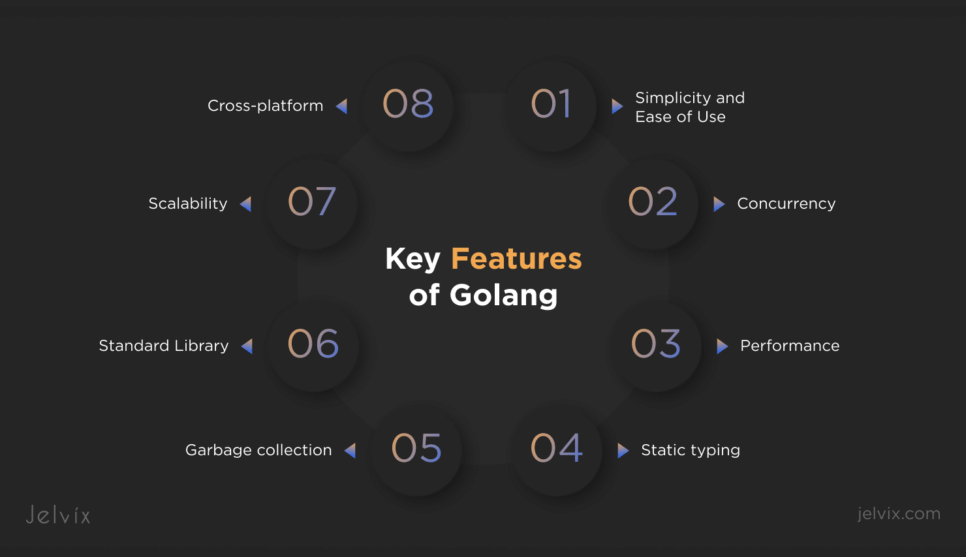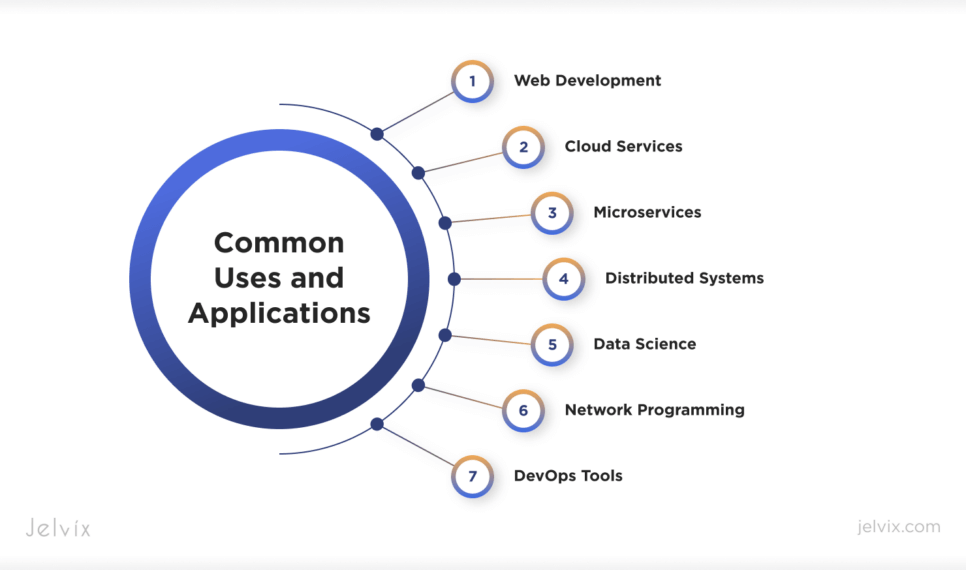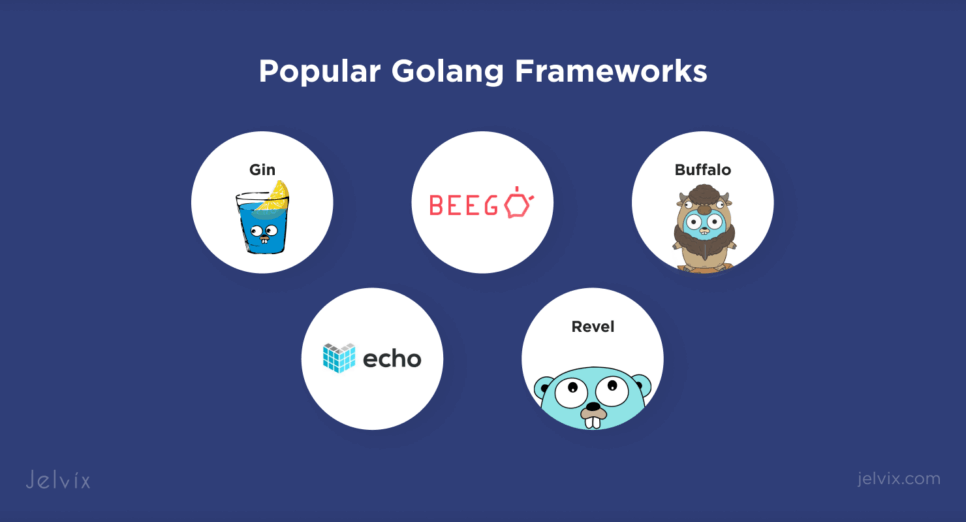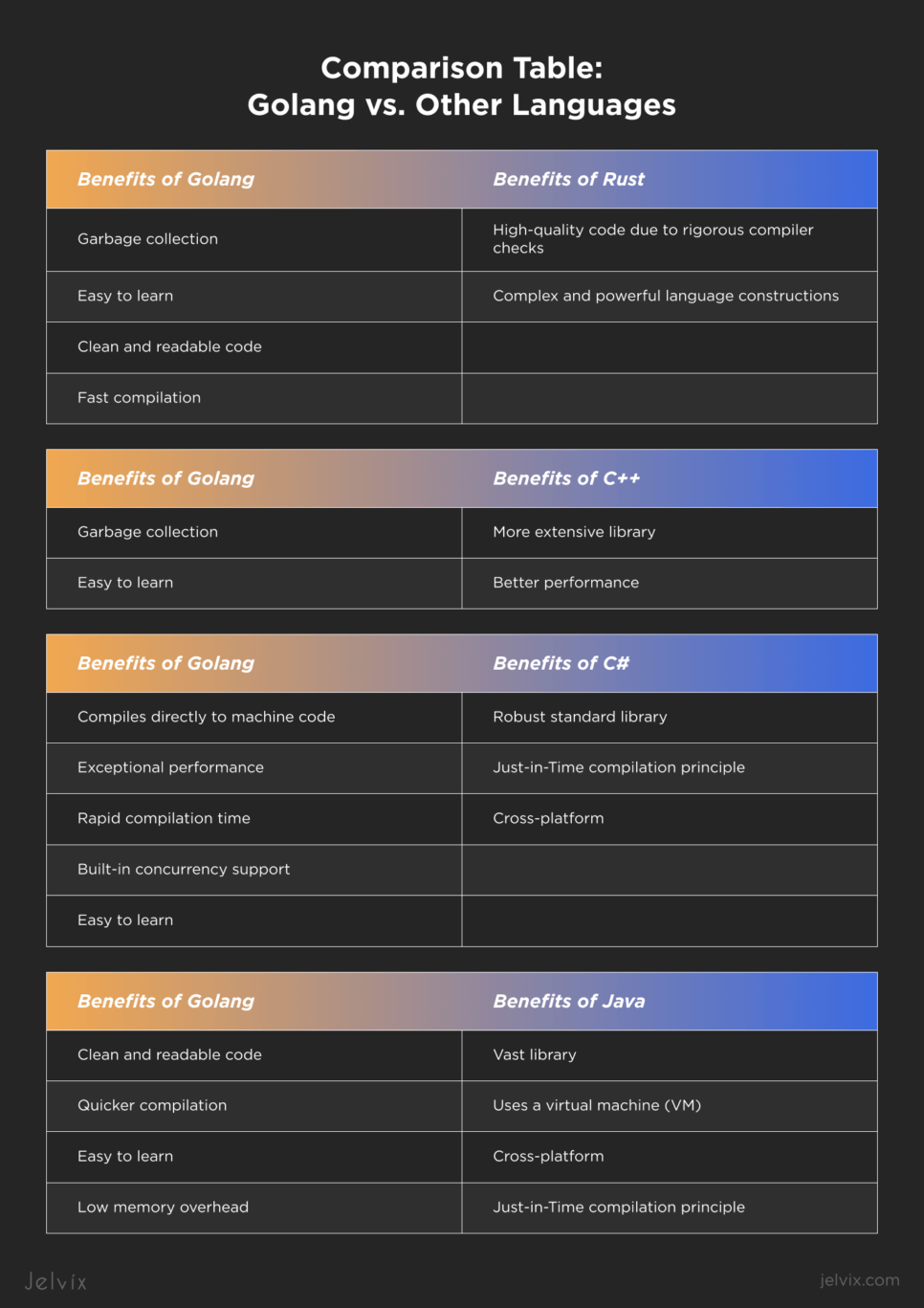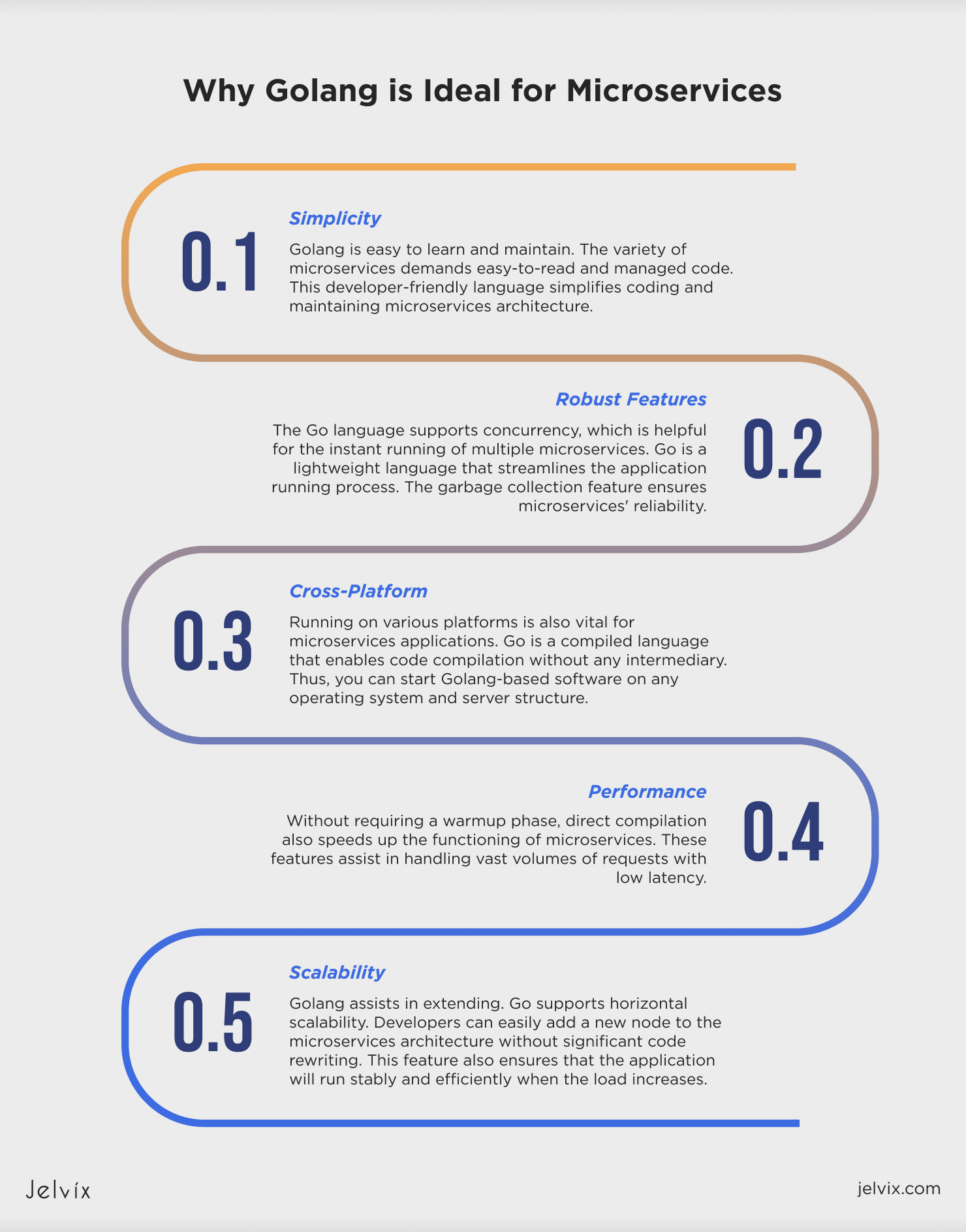Golang, or Go, has become increasingly popular among web developers. Why is this happening? Let’s find out why IT professionals are starting to prefer this particular programming language.
This article describes Golang, its features, typical use cases, and popular frameworks. We also briefly compare Go to other development languages.
This piece will also teach you about the most astounding trends in the IT industry, where this programming language is relevant.
So, let’s delve deep into Golang’s world.
History of Golang
Go, or Golang, is an open-source programming language developed by Google. It is a C-based language with static typing capability.
Go creators aimed to develop a powerful language like C++ that can work with large-scale projects, offering security and efficiency. They also wanted to provide simple, easy-to-type code like Python and create a fast-working alternative to existing languages.
The story of Go started in 2007 when three Google engineers, Robert Griesemer, Rob Pike, and Ken Thompson, who were familiar with Unix, began to design a project.
In November 2009, Go was presented as an open-source project where community members could code and collaborate. Then, in April 2012, version 1.0 was released. Throughout its existence, Golang has evolved. New updates and features, such as generics in 2022, emerge regularly.
Go participates in numerous open-source projects, such as the popular image manipulation library Image Magick, the distributed version control system Git, and the popular text editor Vim. The Go programming language is also a big deal for developers working with Kubernetes, an open-source ecosystem for containerized applications. Golang is one of the most performant languages for implementing distributed systems, such as distributed key-value systems and databases. This language is well known for its scalability and performance, which helps create microservices.
Go has gained popularity among developers and top companies, such as Google, Dropbox, Netflix, Twitch, MongoDB, SoundCloud, and Uber.
Key Features of Golang
- Simplicity and Ease of Use: Go language’s syntax is simple and readable, making it easy to use and comprehend even for developers unfamiliar with the project.
- Concurrency: Concurrency programming is enabled by ‘concurrency primitives’ called goroutines that allow efficient parallel execution of multiple tasks.
- Performance: Direct compiling to machine code enables rapid testing and deployment and ensures that the program runs quicker than with other languages like C++ and Java.
- Static typing: Detecting errors in the written code at compile time prevents typical runtime mistakes and improves application stability.
- Garbage collection: With automatic memory management, developers don’t have to worry about memory leaks and can control resource usage without significant manual work.
- Standard Library: Go language has a comprehensive standard library that offers multiple functionalities, cutting the need for external dependencies and streamlining development.
- Scalability: With Go, developers can build small and large-scale projects that can handle an increasing number of requests in a specific period.
- Cross-platform: Golang supports cross-platform development and enables applications running on different operating systems using a single code base.
Golang’s Common Uses and Applications
Go’s performance, versatility, and scalability features are a source for various applications. Go is significantly valued in development domains that require high performance and multitasking. So, let’s dive deep into the most typical use cases of Golang.
Web Development
Concurrency and built-in HTTP libraries enable efficient web development. Developers can also harness high-performance functionalities enabled by automatic memory management and direct compiling. These capabilities allow big companies like Google, Netflix, SoundCloud, and BBC to handle increasing demand for their services easily.
Cloud Services
Golang perfectly fits cloud services, providing efficient and reliable deployment. This language ensures rapid performance, scalability, and portability for various cloud-based projects. That is why containerization services like Kubernetes and Docker were built on the Go programming language. Google Cloud and other similar services also leverage Golang functionalities to their benefit.
Microservices
Microservices are modular applications that perform specific tasks. They are flexible and independently scalable for each function. This infrastructure requires top-notch performance and low memory usage. Golang is lightweight and fast because of the direct compilation process and garbage cleaning. So, Twitch, a well-known streaming service, leverages Go’s scalability features to cater to the needs of multiple users. The famous ridesharing company Uber utilizes Golang in its geofence microservice to handle numerous customer requests.
Distributed Systems
Concurrency boosts the networking domain. With goroutines and channels, Go is suitable for building network services such as web servers, APIs, and mini frameworks for web platforms.
Data Science
Python and R are leaders in data science development. Nevertheless, Golang’s multitasking functionalities can also be handy for developers in this niche. Its high performance with big data tasks and ability to scale help the Go language stand out. Golang tools and frameworks are also suitable for Machine learning (ML) and data analysis projects.
Network Programming
Golang is handy for developing networking systems. It is applicable for building web servers, proxies, and networking applications. Go ensures reliable functioning of network servers, providing efficient and seamless performance.
DevOps Tools
Development operations, also called DevOps, is a system that assists in task automation and streamlines continuous integration, delivery, and deployment (CI/CD) processes. This method revolutionizes software development, support, and deployment.
Golang has an extensive library that includes various packages needed for robust DevOps. Static typing ensures error handling, and tools like the incorporated HTTP library, file I/O, time, regular expressions, exec, and JSON/CSV greatly help DevOps teams.
Popular Golang Frameworks
The Go language has several frameworks that stand out from the development crowd. Most are simple and productive, ensuring fast and reliable application development. Let’s discuss the most prominent of them below.
- Gin
Gin is one of the core Golang frameworks in 2024. It is written in the Go programming language and is ideal for developers who yearn to create web applications quickly. It is mainly used for writing modular and scalable web software. Gin is fast, lightweight, simple to use, and robust. Its syntax is identical to that of a Python-based CMS, the Django framework. Gin supports middleware, routing, templating, and an integrated testing environment. It can also offer code reusability.
- Beego
Beego is a toolkit for quick REST API development, backend, and web applications. It is also suitable for enterprise-based app development. Beego is written in Go and enables fast and easy web development.
It has features like routing, packing, session management, templating, and an integrated testing environment.
Bee Tool assists in finding code changes. Built-in modules include context handling and ORM support to simplify programming. Libraries for operating HTTP elements and cache handlers are handy in web development.
Beego supports such services as XML-RPC, JSON-RPC, and RESTful APIs.
- Buffalo
Buffalo is rapid and productive. This full-fledged framework is an ideal choice for web development. At the developers’ hands, features such as session management, integrated testing environment, templating, routing, and asset packaging are available.
Buffalo contains hot reloading features in the form of development commands. It is also possible to make changes in web applications in real time. This framework supports data migration, which is helpful for the developers’ community. Its integrated web development ecosystem assists in the backend and frontend development.
Buffalo constantly supports the web development community, providing regular updates and releases.
- Echo
Echo is a Golang framework with exceptional high performance and productivity capabilities. It is mainly used for microservices and assists in crafting web services such as XML-RPC, JSON-RPC, and RESTful APIs.
Echo can be used as a standalone framework or combined with other libraries, such as Gin. Numerous features, such as middleware support, routing, templating, data binding and rendering, automatic TLS, HTTP/2 support, integrated testing environment, and session management, ensure high performance and scalability of web applications.
- Revel
Revel is the latest Go framework for full-stack web development. It has various pre-configured features and functionalities, including routing, asset packaging, templating, integrated testing environment, and session management. Revel is a perfect solution for building APIs regardless of the level of the project’s complexity.
The framework provides continuous support for creating web applications.
Comparing Golang with Other Languages
How does the Go differentiate from other programming languages? Let’s weigh up the similarities and differences between Golang and some of the most popular software development languages.
Golang vs. Rust
Both Golang and Rust support static typing, concurrency, and pointer safety.
The Go language has garbage collection, while Rust doesn’t.
Golang is easy to learn, has a simple syntax, and has appealing documentation. Rust, on the other hand, is complex and challenging to understand and provides non-ordinary language construction and concepts.
Go’s code is clean and readable. Rust’s code is high-quality due to its type system and rigorous compiler checks.
Golang has an active and significant community with many libraries and frameworks. Rust has an active and growing community with an increasing number of frameworks and libraries.
Golang vs. C++
C++ doesn’t have automatic memory management. The Go programming language has garbage collection that ensures memory safety and efficient memory management features, which help reduce runtime errors and dependencies.
Go is a simpler language than C++, although Golang’s syntax is similar to C++.
Go supports concurrency through goroutines and channels. C++ also offers concurrency using coroutines.
Golang is a newer language than C++. So, its library is much smaller than the C++ language.
Golang vs. C#
Go and C# are statically typed languages with features such as garbage collection, type safety, and built-in concurrency support.
Golang compiles straightforwardly to machine code without using mediators like .NET Intermediate Language or Java bytecode. C# is a Windows-based language compiled using Microsoft Intermediate Language (MSIL), which later compiles to native machine code during runtime.
The Go programming language boasts exceptional performance because of rapid compilation time without intermediate or low memory overhead. C# utilizes the Just-in-Time compilation principle.
Both languages are easy to learn because of clear documentation and simple syntax. Golang and C# have robust standard libraries that contain networking data structures, web programming, concurrency, and other features.
C# fits many projects. So, where is C# used most often? Let’s take a look at the best C# uses.
Golang vs. Java
Go has a simpler syntax than Java.
Go language is quicker because it is compiled directly, while Java uses a virtual machine (VM) that reads code and executes corresponding commands.
Java has a vast library compared with small-sized Go’s standard library.
Why Golang is Ideal for Microservices
Go is proving its efficiency in developing distributed systems. Golang is suitable for the modular nature of microservices, which are sets of specific functions. Let’s break down the core reasons why Go is a perfect programming language for microservices.
- Simplicity: Golang is easy to learn and maintain. The variety of microservices demands easy-to-read and managed code. This developer-friendly language simplifies coding and maintaining microservices architecture.
- Robust Features: The Go language supports concurrency, which is helpful for the instant running of multiple microservices. Go is a lightweight language that streamlines the application running process. The garbage collection feature ensures microservices’ reliability.
- Cross-Platform: Running on various platforms is also vital for microservices applications. Go is a compiled language that enables code compilation without any intermediary. Thus, you can start Golang-based software on any operating system and server structure.
- Performance: Without requiring a warmup phase, direct compilation also speeds up the functioning of microservices. These features assist in handling vast volumes of requests with low latency.
- Scalability: Golang assists in extending. Go supports horizontal scalability. Developers can easily add a new node to the microservices architecture without significant code rewriting. This feature also ensures that the application will run stably and efficiently when the load increases.
Future of Golang
Go is unparalleledly efficient and helps developers create network services, distributed systems, cloud computing, and cloud-native services. It is also helpful for database programming, web programming, standalone apps, and DevOps. Those Golang applications will stay relevant in the near future.
There are four main reasons why Go will be popular in the years to come.
- Cloud-based applications are on the rise
Today’s world depends on customer relationship management and big data analysis. Therefore, the demand for cloud-based applications has increased. This trend will remain. Researchers predict that the cloud computing market will reach 946.3 billion dollars by 2026, which will be double what it was worth in 2022.
Golang’s efficiency and integrated concurrency are crucial for cloud-based application development. Google Cloud and Amazon web services value its high performance and robustness. Companies that want to build cloud-native software are constantly seeking Golang developers worldwide, so the demand for such programmers will be high.
- The rising adoption of microservices
Despite its complexity and security issues compared to monolithic architecture, microservices have become popular today. Modular-based microservices architecture is scalable, easy to maintain, and agile. This application-building approach has become the market choice from the nearest perspective and is expected to triple between 2020 and 2026.
The Go programming language has become a top choice for developing microservices. It ensures scalability, cross-platform deployment, and reliable application running with built-in concurrency capability. Market leaders like Google, Amazon, Spotify, and eBay have applied Go to their microservices architectures. Large and small companies seek developers familiar with Golang to create efficiently working microservices.
- The IoT device development
The Internet of Things (IoT) is an innovative wireless technology that connects thousands of internet-connected devices and provides insightful information for data analysis, management, and enhanced user experience. IoT has gained popularity among homeowners, city authorities, manufacturers, and other industries. The demand for IoT devices is constantly rising, streamlining business processes and improving lifestyle. Their number may reach 29 billion by 2030, almost doubling compared to 15 billion in 2020.
Golang’s portability, maintainability, concurrency features, and seamless integration with cloud computing services perfectly suit developing IoT technologies. Go allows connecting and maintaining millions of IoT devices without hindering the system’s performance. The Gobot framework written in Golang is an efficient tool for creating IoT applications, such as smart homes, security systems, and other devices.
- Golang is a relatively new but promising programming language
Go is a young language compared to well-known giants like Java and C++. The demand for web developers is constantly growing. Consequently, the number of developers working with the Go language is insufficient for market needs. Therefore, the labor cost is increasing with the rising demand from companies worldwide.
For instance, according to Glassdoor, the average Golang developer salary in the United States in May 2024 is $122,458. The most likely salary range is from $94,000 to $162,000. Golang programmers’ earnings are higher compared with Java developers’ income.
Therefore, the hourly salary rate is also high for Go developers. The average hourly rate for Go’s projects is $58 in the USA. Such a situation on the market provides multiple lucrative opportunities for freelancers.
The Golang community is permanently evolving. Regular framework updates and releases ensure that development with the Go programming language will be relevant in the future.
Conclusion
Golang is a go-to choice for web developers. They can successfully utilize the powerful standard library, built-in concurrency, static typing, automatic memory management, and direct compilation. The Go language is also relevant for projects that require high performance, cross-platform compatibility, and scalability.
Golang’s use cases include web development, including backend and frontend development, creating databases, microservices architecture, IoT, cloud-based services, distributed systems, data science, and DevOps tools.
With Go’s top professionals, companies can significantly improve their productivity and efficiency and seamlessly scale up.
Consider Golang as an apt option for your future projects.
FAQ
What is Golang primarily used for?
Golang, or Go, has numerous applications. This language is worth using to develop network services, web applications, microservices, cloud services, data computing software, distributed systems, and utilities. It is also a perfect tool for DevOps. Golang’s standard library helps develop applications that require robustness, concurrency, easy maintenance, and scalability.
What makes Golang suitable for developing microservices?
Go is a perfect match for microservices architecture. Lightweight, with simple syntax and native concurrency features, Golang ensures fast performance and robustness. It also enables horizontal scalability, easily adding new microservice functions without harming the whole system’s performance.
How does Golang compare to other programming languages like Rust and C++?
Compared to Rust, Golang is simpler to grasp and utilize, while Rust provides better memory safety and performance. Compared to C++, the Go language includes such convenient features as garbage collection and built-in concurrency while still delivering high performance.
What are some popular frameworks available for Golang?
There are a few well-known Golang frameworks, such as Gin, which is fast and lightweight; Buffalo, which ensures rapid development; a flexible Beego; Echo, which has high performance with middleware support; and Revel, which helps master full-stack development.
Is Golang a good choice for web development?
Yes, it is. Go is a perfect option for web developers because of its powerful standard library, simple syntax, and robust frameworks, suitable for building efficient and scalable web applications.
Need a qualified team of developers?
Use our talent pool to fill the expertise gap in your software development.


